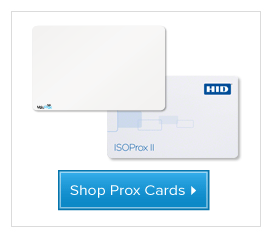If you're new to proximity cards, you may have seen or heard a reference to the acronym "LGGMN." But what does "LGGMN" mean?
The acronym refers to each of the five options for programming proximity cards. When ordering prox
cards for the first time, it's important to understand what it is you're ordering to ensure accurate and timely processing.
On occasion, customers have gotten confused when attempting to order cards on their own and ended up ordering the wrong programming options and/or card configuration (this information is located on the "Options" tab of each prox card's product description page).
This blog will focus specifically on the requirements for ordering HID and ValuProx proximity cards.
 Always save the original box that the previous order of proximity cards were sent to you in; these boxes contain the pertinent information you need for future orders.
Always save the original box that the previous order of proximity cards were sent to you in; these boxes contain the pertinent information you need for future orders.
The "LGGMN" programming configuration is the most common for printable HID and ValuProx

proximity cards, and it is also a universal term that's used synonymously with these two brands. There are five criteria customers must select when ordering the LGGMN configuration, including:
1. Programmed or non-programmed
- L: Programmed
- N: Non-programmed
It's more convenient to have cards pre-programmed when you order them, because programming can be a complex process that most companies are not equipped to manage internally.
2. Card front surface options
- G: Plain white PVC with gloss finish – surface is intended to be printed upon
- C: Custom artwork – surface features custom artwork
This refers to the front of the prox cards. ValuProx cards feature a plain, white surface on the front. Although most customers do not select this option, HID can print custom artwork onto cards if the artwork is provided. This option is more expensive and takes longer to process.
3. Card back surface options
- G: Plain white PVC with gloss finish – surface is intended to be printed upon
- S: Standard ISOProx II artwork gloss finish – HID cards have "ISO Prox HID" printed on the card
- C: Custom artwork – surface features custom artwork
This options refers to the back of the prox cards. ValuProx cards feature a plain, white surface on the back with a small "ValuProx" logo. In addition, HID's cards has "ISO Prox HID" printed on the back of the card.
4. Card numbering options*
- M: The programmed card number inside the card is the same as the number printed on the outer surface of the card.
- S: Sequential internal/sequential non-matching external card numbering (a security feature some
companies choose as they do not want the programmed numbers inside the card to match the
numbers on the outside)
5. Slot punch / no slot punch
- N: No hole in the card (no punch) – Cards that are intended to be printed upon and punched after the printing process is complete
- V: Vertical slot punch – a common option (however, with pre-punched cards, there is a chance that the hole may damage the printer's printhead which can be a costly repair or replacement ($500 - $600)
- H: Horizontal slot punch – a common option (however, with pre-punched cards, there is a chance that the hole may damage the printer's printhead which can be a costly repair or replacement ($500 - $600)
| For help with your next proximity card order or for questions you might have about your the configuration options, call a knowledgeable ID Professional at (800) 321-4405 x2 or chat now. |
*Inkjetted external card numbers are being phased out by HID. HID cards may arrive with engraved numbering.
 Always save the original box that the previous order of proximity cards were sent to you in; these boxes contain the pertinent information you need for future orders.
The "LGGMN" programming configuration is the most common for printable HID and ValuProx
Always save the original box that the previous order of proximity cards were sent to you in; these boxes contain the pertinent information you need for future orders.
The "LGGMN" programming configuration is the most common for printable HID and ValuProx  proximity cards, and it is also a universal term that's used synonymously with these two brands. There are five criteria customers must select when ordering the LGGMN configuration, including:
1. Programmed or non-programmed
proximity cards, and it is also a universal term that's used synonymously with these two brands. There are five criteria customers must select when ordering the LGGMN configuration, including:
1. Programmed or non-programmed
